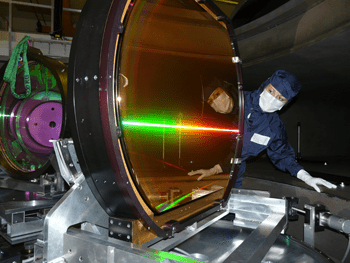An international team of physicists have used one of the world’s most powerful lasers to create an unusual kind of plasma made out of hollow atoms, by using a breakthrough technique which involved emptying atoms of electrons from the inside out, instead of working from the outer shells inwards. This bizarre physics experiment shows once again just how important X-rays are in physics interaction and deepens our understanding of fusion.

A hallow atom is created when electrons nested deep inside the atom are removed, typically by colliding the said electrons with other electrons, creating a “hole” inside the atom, while leaving the other electrons in place. Through this process, a distinct form of plasma is formed, and if the hole is filled X-rays are released. Plasma is a form of ionized gas, which mainly differentiates itself through its highly conductive electrical properties. In nature, a great example of plasma at work is lightning. Neon lights also make for a familiar display of plasma since its the latter which produces the light.
For their experiment, the researchers used the petawatt laser at the Central Laser Facility at the Science and Technology Facilities Council (STFC) Rutherford Appleton Laboratory to zap individual atoms. For context, the petawatt laser delivers approximately 10,000 times the entire UK national grid, all in one zap lasting a thousand-billionth of a second, onto an area smaller than the end of a human hair. Impressed yet?
“At such extraordinary intensities electrons move at close to the speed of light and as they move they create perhaps the most intense X-rays ever observed on Earth. These X-rays empty the atoms from the inside out; a most extraordinary observation and one that suggests the physics of these interactions is likely to change, as lasers become more powerful,” said Dr Nigel Woolsey, from the York Plasma Institute, Department of Physics, at the University of York was the Principal Investigator for the experimental work.
A hallow atom from the inside out
So, unlike previous attempts to create hallow atoms, the current work doesn’t rely on electron or photon collision to create atom holes, instead it uses the resulting radiation field from the interaction to achieve the same effect; only from the inside out.
“This experiment has demonstrated a situation where X-ray radiation dominates the atomic physics in a laser-plasma interaction; this indicates the importance of X-ray radiation generation in our physics description. Future experiments are likely to show yet more dramatic effects which will have substantial implications for diverse fields such as laboratory-based astrophysics,” said Co-author Dr Alexei Zhidkov, from Osaka University.
The experiments provides further insight into fusion research, which offers the potential for for an effectively limitless supply of safe, environmentally friendly energy.
Co-author Dr Sergey Pikuz, from the Joint Institute for High Temperatures RAS, said: “The measurements, simulations, and developing physics picture are consistent with a scenario in which high-intensity laser technology can be used to generate extremely intense X-ray fields. This demonstrates the potential to study properties of matter under the impact of intense X-ray radiation.”
Co-author Rachel Dance, a University of York PhD physics student, said: “This was a very dynamic experiment which led to an unexpected outcome and new physics. The hollow atom diagnostic was set to measure the hot electron beam current generated by the laser, and the results that came out of this in the end, showed us that the mechanism for hollow atom generation, was not collisional or driven by the laser photons, but by the resulting radiation field from the interaction.”
Findings were reported in the journal Physical Review Letters.


